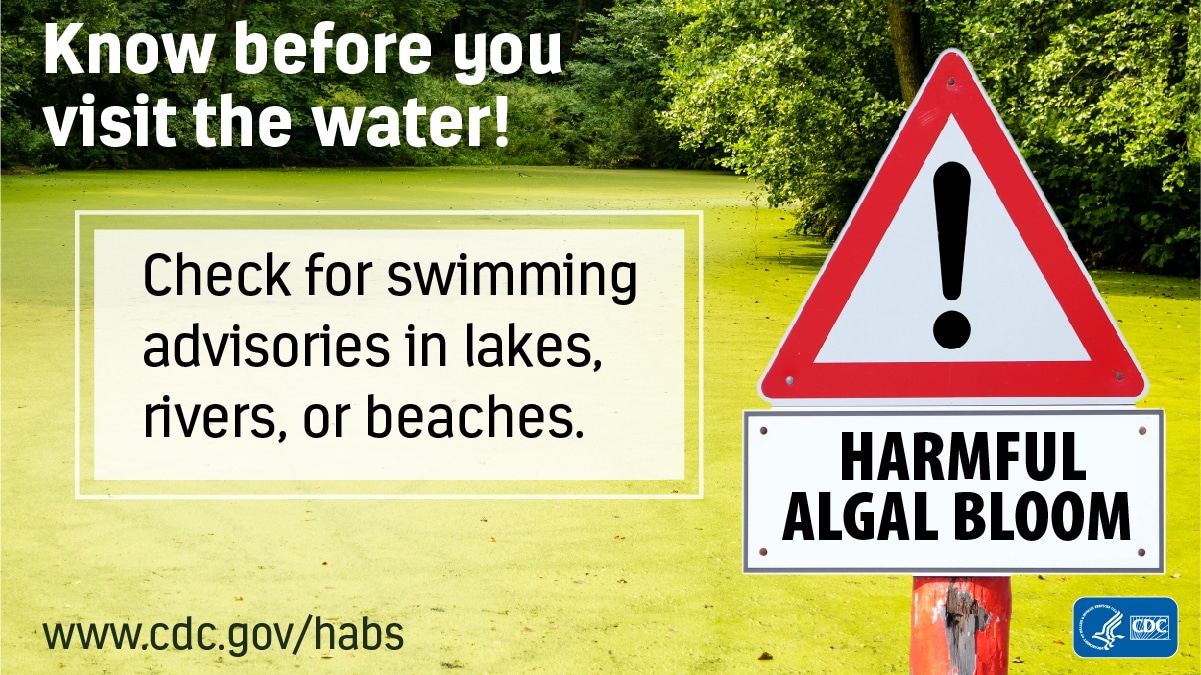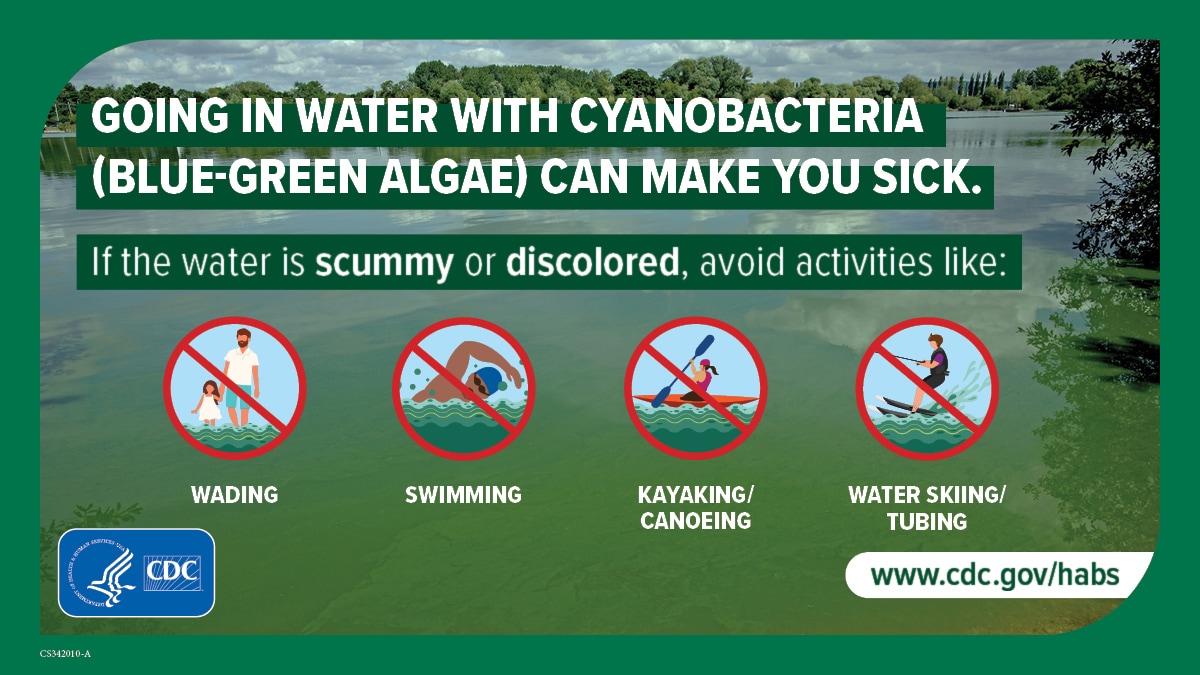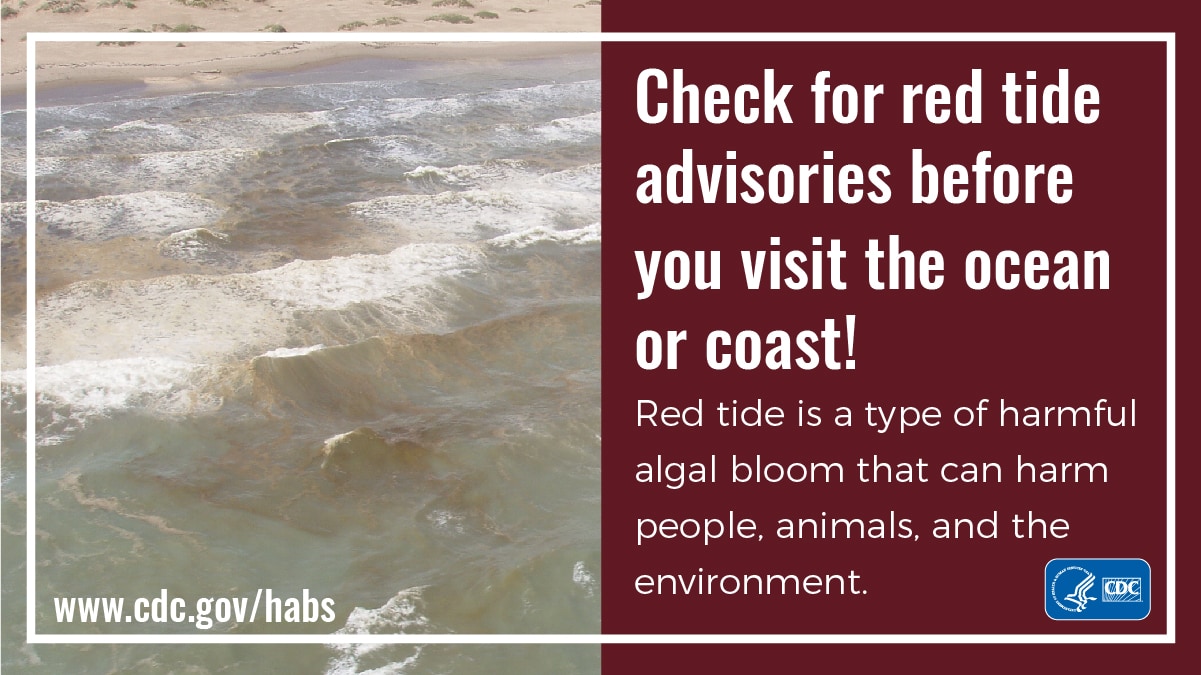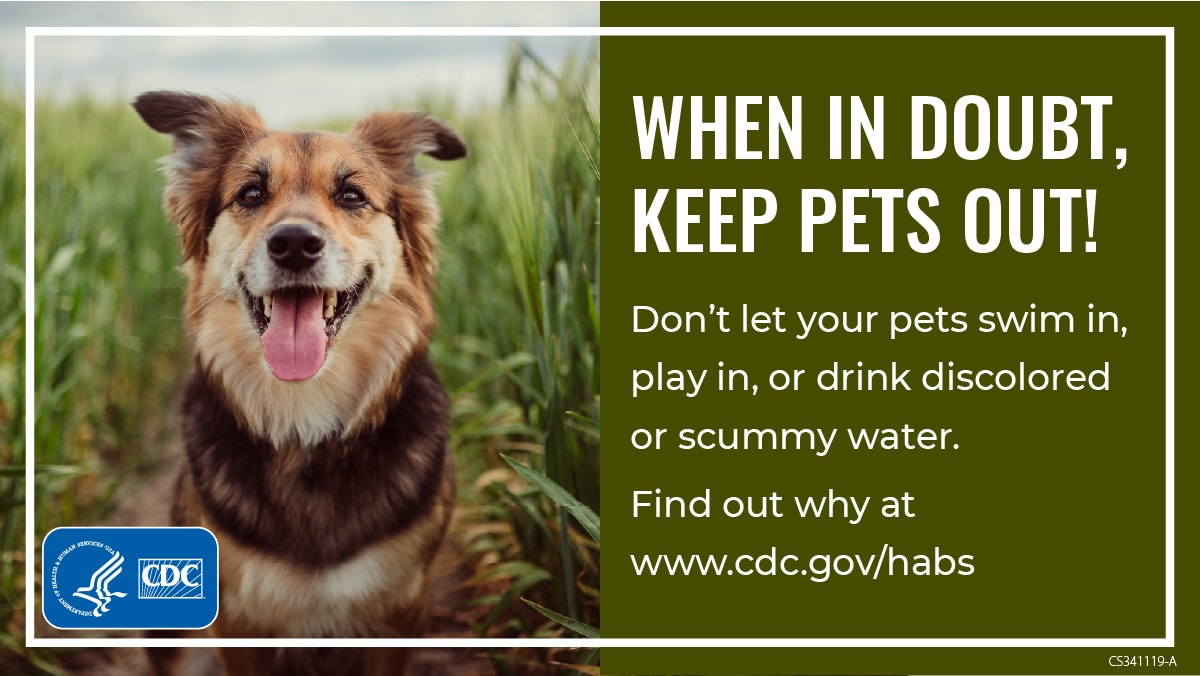What to know
Use and share the social media messages, graphics, and videos below about how to avoid getting sick from harmful algal blooms.
Get the facts
Messages
- Harmful algal blooms can make you, your family, and your pets sick. Watch and share: youtube.com/watch?v=50w0_IwqSKs
- Harmful algae and cyanobacteria can make toxins that hurt people, animals, and the environment. Learn what they are and how to avoid them: cdc.gov/habs
- Do you know how to spot a bloom of harmful algae or cyanobacteria? Blooms can look like foam or scum on the surface of water. They can also be different colors, like green, blue, red, or brown. Don’t go into water with a harmful bloom. cdc.gov/habs
- Does the water look scummy or discolored, or smell like rotting plants? These could be signs of harmful algae or cyanobacteria, which can harm you and your pets. cdc.gov/habs
- Blooms of harmful algae and cyanobacteria occur across the world. Harmful algae and cyanobacteria can grow in fresh water, salt water, and brackish water (a mixture of fresh and salt water). cdc.gov/habs
Graphics and videos
Watch and share this video about keeping yourself and your pets safe from harmful algal blooms.
Download and share this graphic. Available in English, Spanish, and multiple sizes.
Download and share this graphic. Available in English, Spanish, and multiple sizes.
Prevent illness
Messages
Safe swimming
- Avoid getting sick from harmful algal blooms by following water advisories and staying out of scummy, stinky, or discolored water. cdc.gov/habs
- Before swimming, boating, or fishing, learn tips to help you spot harmful algae and cyanobacteria (blue-green algae). Avoid getting sick by staying out of water with these signs: cdc.gov/habs
- When in doubt, stay out! You can't tell for sure if an algal or cyanobacterial bloom is harmful just by looking at it. Protect yourself and your pets by not swimming in bodies of water that smell bad or look discolored. cdc.gov/habs
- Headed to the lake or beach this weekend? Look for swimming advisories and water quality notices online or near the water before visiting. cdc.gov/habs
- Breathing in airborne droplets or mist that contain toxins from red tides in the Gulf of Mexico can cause your eyes to burn or make you cough and sneeze. Check for red tide advisories from your state or local government before visiting the ocean or coast. cdc.gov/habs
Safe seafood
- Eating fish or shellfish from water with a harmful algal bloom can make you sick. Check for local advisories before fishing or collecting shellfish. cdc.gov/habs
- Check for and follow local shellfish and fish advisories before eating any fish or shellfish you collect yourself. Algal and cyanobacterial toxins in fish or shellfish have no taste or odor. cdc.gov/habs
Symptoms and treatment
- Toxins from harmful algae or cyanobacteria can make you sick if you swallow, touch, or breathe in droplets from contaminated water. Learn the common signs and symptoms: cdc.gov/habs
- If you get sick after going in or near water, call a doctor or Poison Control at 1-800-222-1222. cdc.gov/habs
Graphics and videos
Watch and share this video about keeping yourself and your pets safe from harmful algal blooms.
Download and share this graphic. Available in English, Spanish, and multiple sizes.
Download and share this graphic. Available in English, Spanish, and multiple sizes.
Download and share this graphic. Available in English, Spanish, and multiple sizes.
Download and share this graphic. Available in multiple sizes.
Download and share this graphic. Available in English, Spanish, and multiple sizes.
Protect pets and livestock
Messages
Pets
- Do not let your pets swim in, play in, or drink water that looks discolored or has foam or scum on the surface. These could be signs of harmful algae or cyanobacteria, which can be deadly for pets. cdc.gov/habs
- Cyanobacteria (blue-green algae) can be deadly for dogs if they swallow contaminated water. When visiting lakes and streams, keep your pets safe by bringing plenty of water for them to drink and not letting them eat algae. cdc.gov/habs
- If your pet gets into scummy or discolored water, rinse them off with tap water right away and don’t let them lick their fur. Algal and cyanobacterial toxins could be in the water. Call a vet right away if your pet seems sick. cdc.gov/habs
- If your pet gets sick after going in or near water, call a veterinarian right away. Dogs can get very sick and die within hours of drinking or going in water with a harmful algal bloom. cdc.gov/habs
Livestock
- Do you own livestock, such as cows or sheep? Keep livestock away from scummy or discolored water. Water that contains cyanobacterial toxins can be deadly for animals. cdc.gov/habs
Graphics
Download and share this graphic. Available in English, Spanish, and multiple sizes.
Download and share this graphic. Available in multiple sizes.
Download and share this graphic. Available in English, Spanish, and multiple sizes.
Download and share this graphic. Available in English, Spanish, and multiple sizes.
Download and share this graphic. Available in English, Spanish, and multiple sizes.
Environmental connection
Messages
- Did you know? Climate change can increase the growth of harmful algae and cyanobacteria in fresh, salt, and brackish water. It can make blooms occur more often and be more severe. cdc.gov/habs
- Harmful algae and cyanobacteria are a One Health issue that affects people, animals, and the environment. cdc.gov/habs
Graphic
Download and share this graphic. Available in English, Spanish, and multiple sizes.














